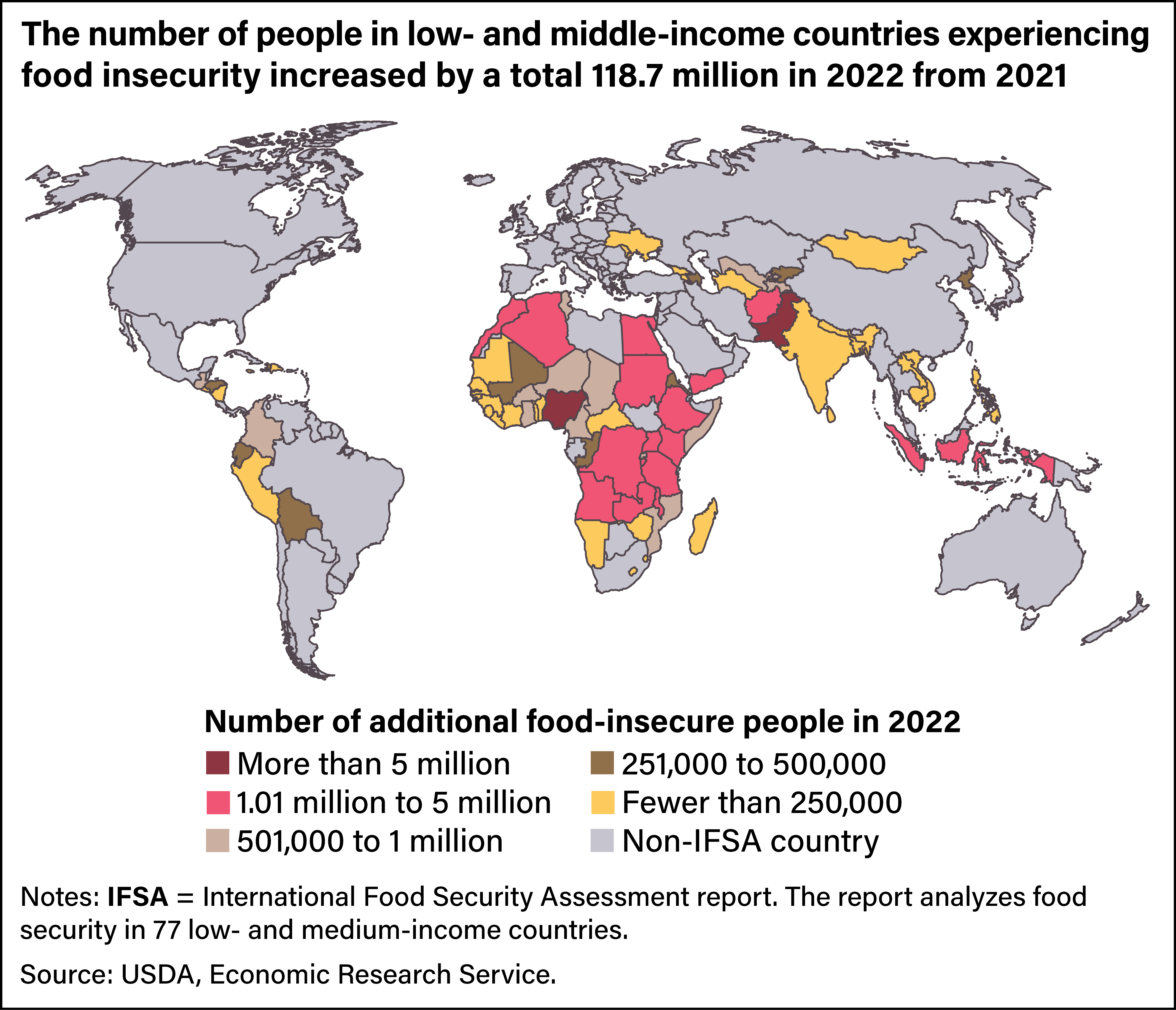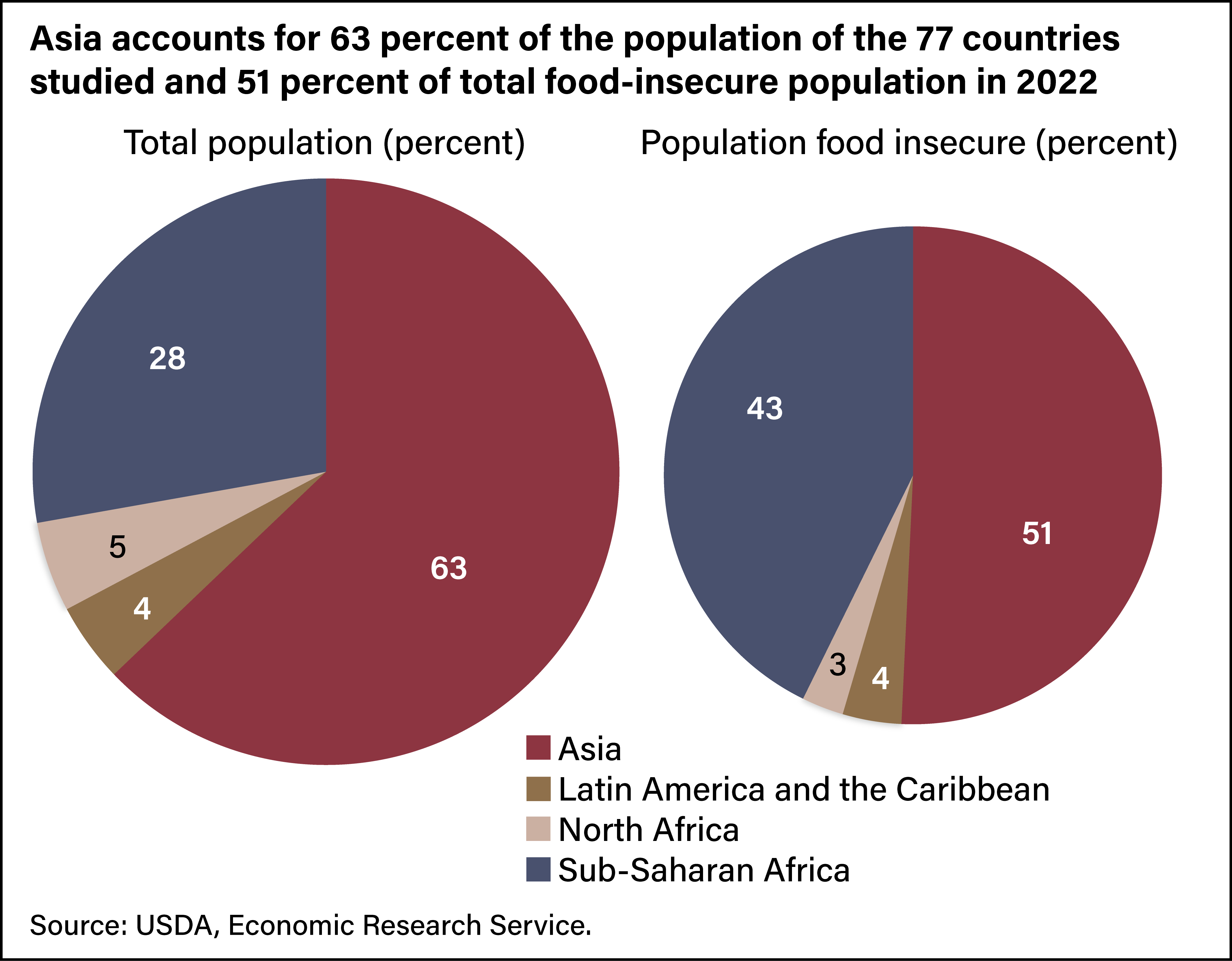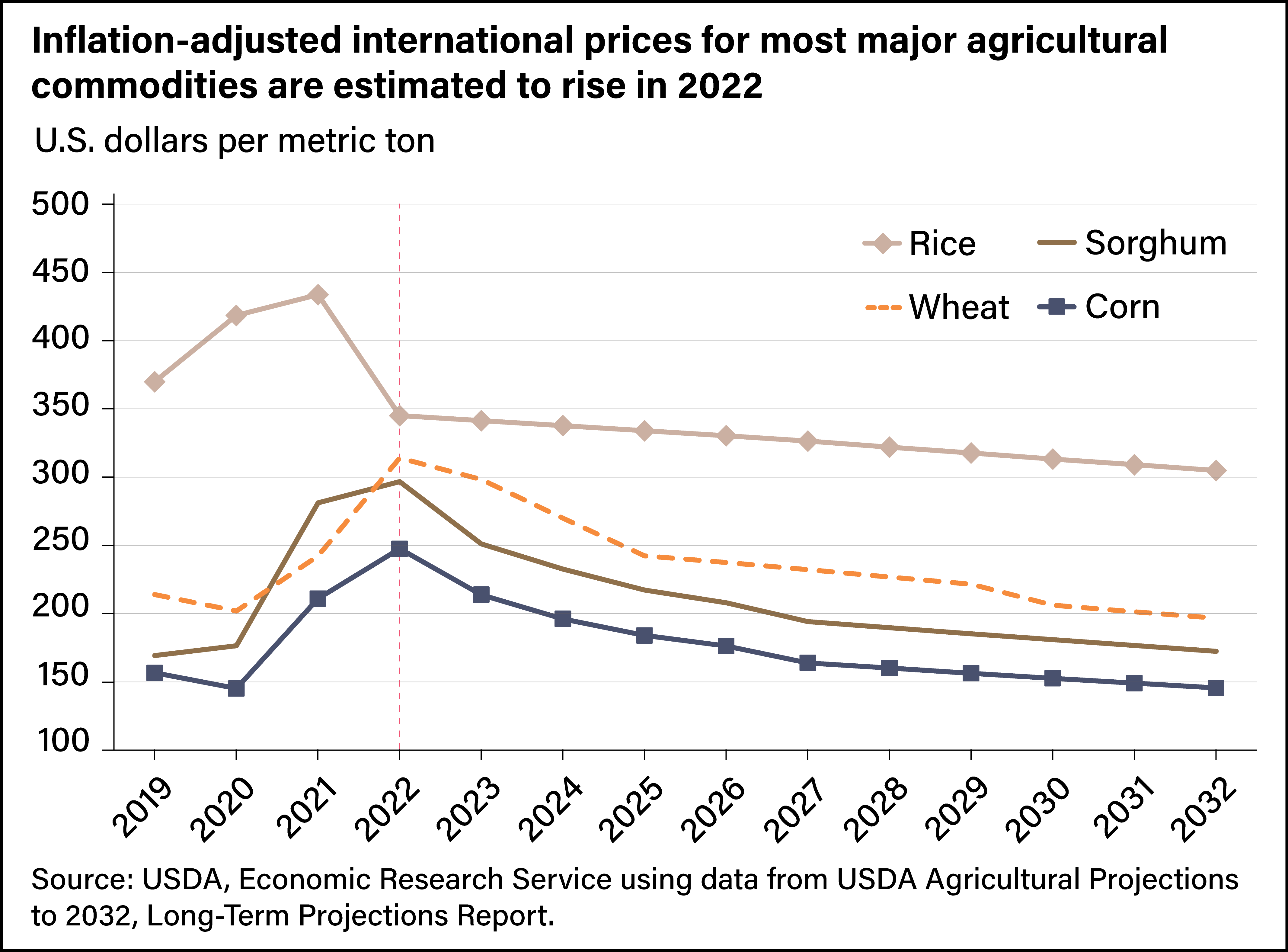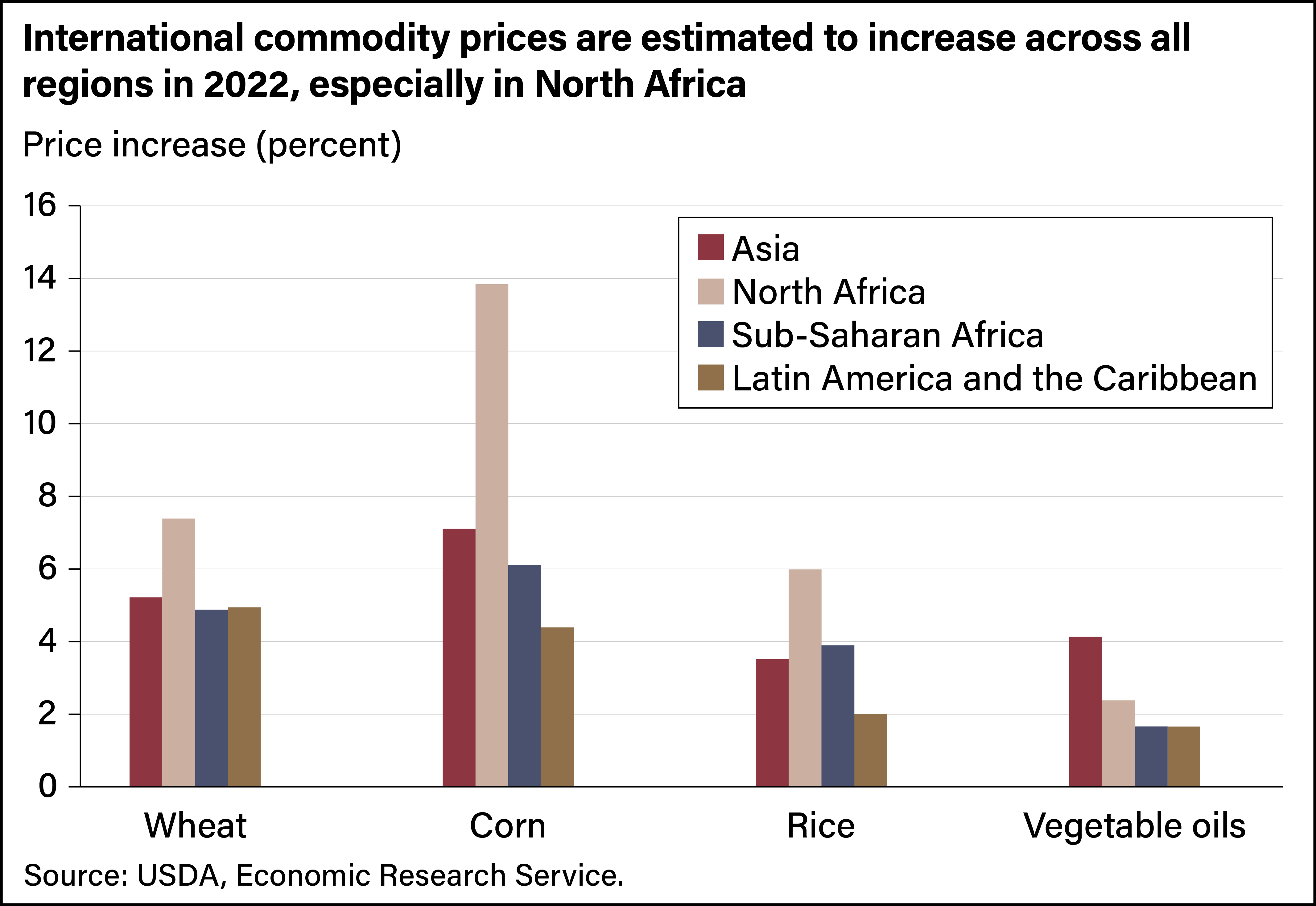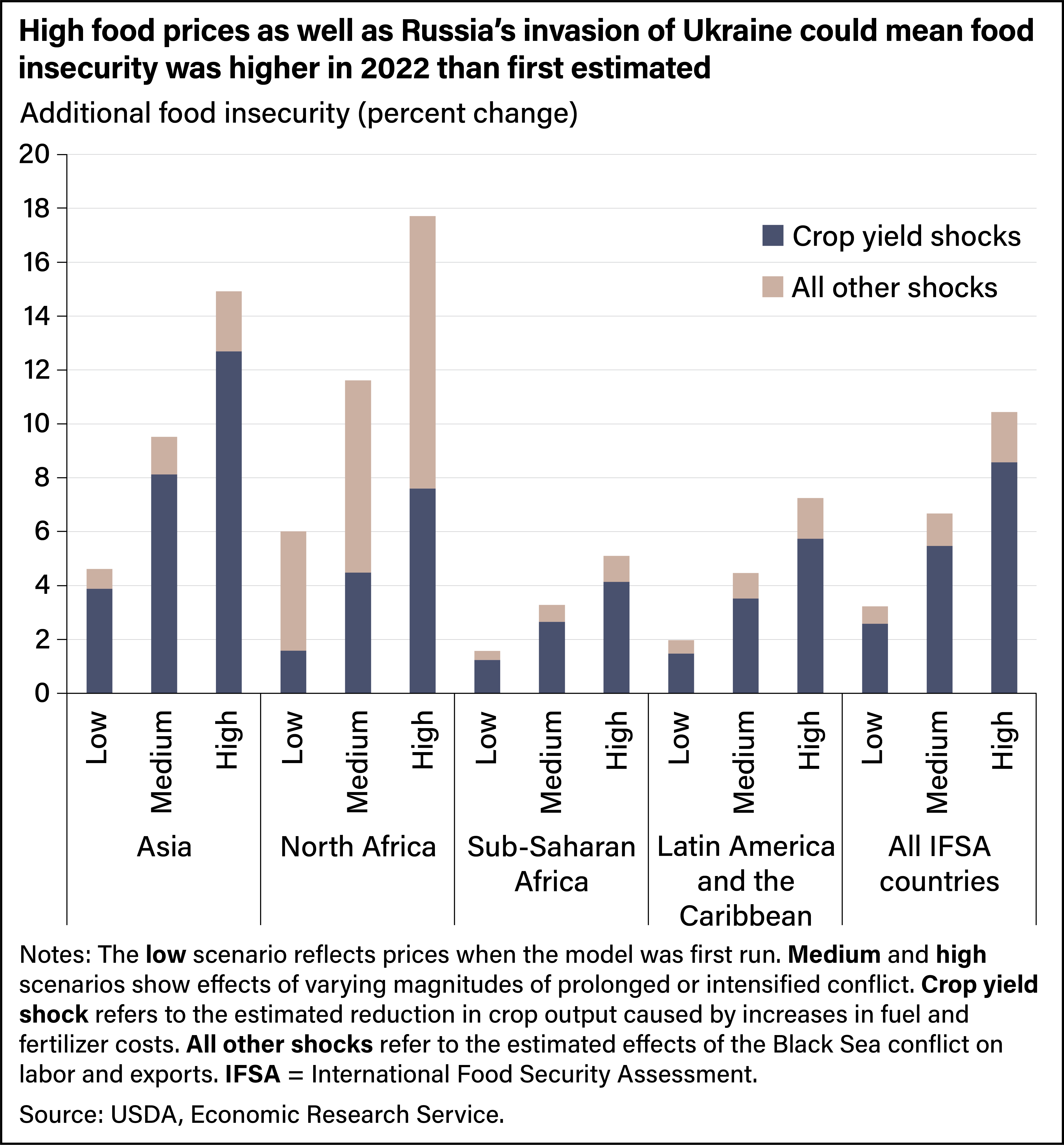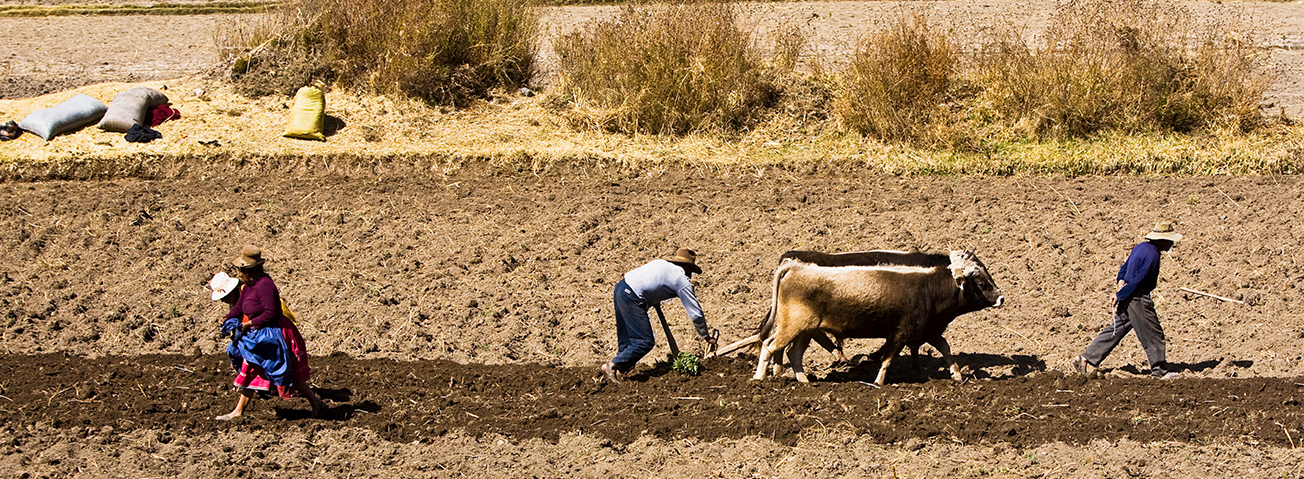
Global Food Insecurity Grows in 2022 Amid Backdrop of Higher Prices, Black Sea Conflict
- by Yacob Abrehe Zereyesus and Lila Cardell
- 11/28/2022
Highlights
- Despite positive income growth anticipated for the majority of the 77 countries in the assessment, food insecurity in 2022 is estimated to increase from 2021. The number of food-insecure people in 2022 is estimated at 1.3 billion, an increase of 10 percent from the 2021 estimate.
- The increase reflects two main factors: food price inflation, which is estimated to outpace growth rates of real per capita Gross Domestic Product (GDP), and uncertainty surrounding exports of feed grains, oilseeds, vegetable oils, and wheat from the Black Sea region following Russia’s invasion of Ukraine.
- Food security is projected to improve in all 77 countries over the next 10 years. By 2032, the number of food-insecure people in the 77 IFSA countries is projected to be 577.3 million and falling to 12 percent of the population (64.0 percent less than in 2022).
People are food insecure when they lack access to sufficient, safe, and nutritious food that meets their needs for an active and healthy life, according to the Food and Agriculture Organization of the United Nations. Food availability—physical and financial—affects the prevalence of international food security. In 2021, a rapid increase in commodity prices driven by rising global demand for feed and food grains as well as drought in South America, supply chain disruptions and shipping bottlenecks in various countries, and higher energy prices affected food availability. Prices rose even higher in 2022, partly fueled by Russia’s invasion of Ukraine and persistently high fuel and fertilizer prices. Access to food increasingly became a challenge, especially for millions of people in low- and middle-income countries, where the most vulnerable populations of the world live.
USDA, Economic Research Service (ERS) tracks food security trends in 77 low- and middle-income countries in four regions—Sub-Saharan Africa, North Africa, Latin America and the Caribbean, and Asia— in its annual International Food Security Assessment (IFSA). This year, ERS researchers found that with commodity prices rising in 2022, the prevalence of global food insecurity also grew. Overall, the number of food-insecure people in 2022 is estimated at 1.3 billion, an increase of 118.7 million people, or 10 percent, from ERS’ 2021 estimate. Moreover, almost 33 percent of the population of the IFSA countries is considered food insecure in 2022.
While food security is estimated to have deteriorated in most countries in 2022, the magnitude varies across regions. Sub-Saharan Africa has the highest share of people who are food insecure at 51 percent, reflecting the effects of food price inflation for low-income populations across the region. Food insecurity in the Latin America and the Caribbean region is estimated at 29 percent and in Asia at 27 percent. North Africa is the most food-secure region in the IFSA analysis with estimated food insecurity at 18 percent among its population in 2022. However, as the chart below shows, Asia’s food-insecure population accounts for 51 percent of the total food-insecure population of the 77 IFSA countries, followed by Sub-Saharan Africa at 43 percent.
For the 77 countries studied in the annual IFSA report, ERS economists project food insecurity over the next 10 years using data on food availability, prices, and measure of demand relative to price and income changes. They then compare estimated food demand in those countries and regions against a nutritional threshold of 2,100 kilocalories per person per day. The calorie threshold is an internationally agreed-upon level set by the United Nations as the recommended level of dietary energy intake for a healthy, well-nourished individual.
Despite challenges in the near-term outlook, ERS projects food security trends in IFSA countries to improve in the next decade. Food commodity prices are projected to stabilize or to decline in some cases. Average per capita Gross Domestic Product (GDP)—a proxy for income—is expected to increase, making food more financially accessible. By 2032, the share of the population that is food insecure in the 77 countries is projected at 12 percent, a 63-percent drop from the 2022 estimate. The number of people considered food insecure is projected to decline 57 percent from the 2022 estimate to 577.3 million people by 2032.
The 2022 IFSA Accounts for the Russian Invasion of Ukraine
The 2022 IFSA also incorporates the potential consequences of global events such as Russia’s military invasion of Ukraine in February 2022 as well as the effect of high input costs on food prices. Researchers modeled lower crop yields stemming from higher fuel and fertilizer prices and considered the effect of reduced exports of feed grains, oilseeds, vegetable oils, and wheat from Ukraine and Russia. The consequences of Russia’s invasion of Ukraine, along with higher fertilizer and fuel prices, amplified the prevalence of food insecurity in IFSA countries by more than 3 percent from pre-invasion estimates in 2022. The Russia-Ukraine conflict and rising input costs are attributed with creating food insecurity for 42 million of the total 118.7 million people who were characterized as being food insecure in 2022.
Elevated International Food Commodity Prices Persist in 2022
Domestic food prices become integrated with international prices through trade, so the IFSA model uses USDA’s international agricultural commodity price projections to assess the potential impact of food prices on food access in the 77 IFSA countries. Rising global demand for feed and food grains and reduced global supplies have shifted price projections upward since 2021, and this is expected to continue through 2022 for commodities such as corn, wheat, and sorghum (see chart below). Recent increases in international prices of wheat, coarse grains, and vegetable oils have intensified as a result of Russia’s invasion of Ukraine. This event has reduced exports, particularly of wheat, corn, and sunflower oil from the Black Sea region and added uncertainty in world commodity markets. Before the invasion, international commodity price increases and supply shortages already were driving up domestic food prices, especially in low- and middle-income countries. Prices of inputs for crop production such as fertilizer and fuel began increasing in late 2021 and continued increasing after Russia invaded Ukraine.
Inflation-adjusted domestic prices of the major grains in 91 percent of IFSA countries were projected to rise in 2022 relative to 2021. On average, the regions most affected by Russia’s invasion of Ukraine and hikes in input prices were North Africa and Asia (see chart below). ERS estimates North Africa, which ordinarily relies on wheat and corn imports from the Black Sea region, to see price increases of 7 percent for wheat and 14 percent for corn in 2022. ERS projects prices in Asia to increase 7 percent for corn and 5 percent for wheat in 2022.
The Increase in Food Insecurity in 2022 Could Still Be Understated, According to Alternate Scenarios
The intensity and duration of Russia’s military invasion of Ukraine and continued high fertilizer and fuel prices could lead to higher food insecurity in low- and middle-income countries beyond ERS' original estimates. Researchers considered two additional scenarios illustrating the effect of lower commodity yields (representing the increase in input costs) and impacts to labor and export markets. In one scenario (denoted as “medium” in the chart below), an additional 7 percent of the IFSA population was estimated to be food insecure, representing an additional 86.1 million people facing food insecurity in 2022. The high scenario included in this analysis estimated that an additional 10 percent of the IFSA population (134.7 million people) could be considered food insecure in 2022 because of a prolonged or intensified conflict. The prevalence of food insecurity is expected to increase the most in Asia and North Africa in both the medium and high scenarios.
This article is drawn from:
- Zereyesus, Y.A., Cardell, L., Valdes, C., Ajewole, K., Zeng, W., Beckman, J., Ivanic, M., Hashad, R.N., Jelliffe, J. & Kee, J. (2022). International Food Security Assessment, 2022–32. U.S. Department of Agriculture, Economic Research Service. GFA-33.
You may also like:
- Baquedano, F.G., Zereyesus, Y.A., Valdes, C. & Ajewole, K. (2021, September 7). Food Insecurity to Increase in 2021 at a Higher Rate in Lower Income Countries. Amber Waves, U.S. Department of Agriculture, Economic Research Service.
- Zereyesus, Y.A., Baquedano, F.G. & Morgan, S. (2022). Evaluating the Prediction Performance of the International Food Security Assessment’s Production Models: A Cross-Validation Approach. U.S. Department of Agriculture, Economic Research Service. TB-1959.
- Baquedano, F.G., Zereyesus, Y.A., Valdes, C. & Ajewole, K. (2021). International Food Security Assessment, 2021-31. U.S. Department of Agriculture, Economic Research Service. GFA-32.
- Bloem, J., Michler, J.D., Josephson, A. & Rudin-Rush, L. (2022). COVID-19 Working Paper: Food Insecurity During the First Year of the COVID-19 Pandemic in Four African Countries. U.S. Department of Agriculture, Economic Research Service. AP-102.
We’d welcome your feedback!
Would you be willing to answer a few quick questions about your experience?


